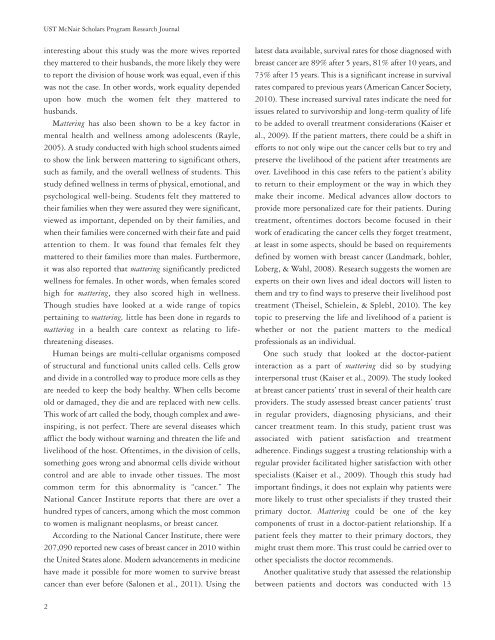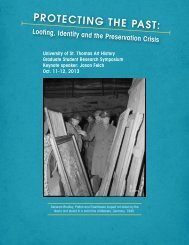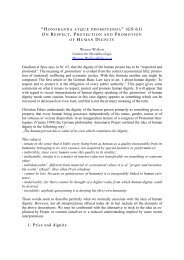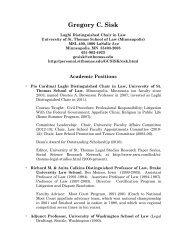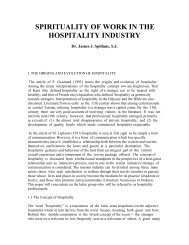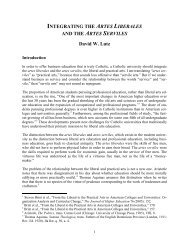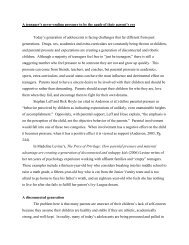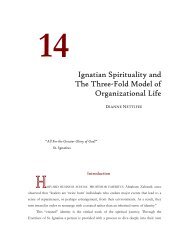dr. ronald e. mcnair acknowledgements - University of St. Thomas
dr. ronald e. mcnair acknowledgements - University of St. Thomas
dr. ronald e. mcnair acknowledgements - University of St. Thomas
Create successful ePaper yourself
Turn your PDF publications into a flip-book with our unique Google optimized e-Paper software.
UST McNair Scholars Program Research Journal<br />
interesting about this study was the more wives reported<br />
they mattered to their husbands, the more likely they were<br />
to report the division <strong>of</strong> house work was equal, even if this<br />
was not the case. In other words, work equality depended<br />
upon how much the women felt they mattered to<br />
husbands.<br />
Mattering has also been shown to be a key factor in<br />
mental health and wellness among adolescents (Rayle,<br />
2005). A study conducted with high school students aimed<br />
to show the link between mattering to significant others,<br />
such as family, and the overall wellness <strong>of</strong> students. This<br />
study defined wellness in terms <strong>of</strong> physical, emotional, and<br />
psychological well-being. <strong>St</strong>udents felt they mattered to<br />
their families when they were assured they were significant,<br />
viewed as important, depended on by their families, and<br />
when their families were concerned with their fate and paid<br />
attention to them. It was found that females felt they<br />
mattered to their families more than males. Furthermore,<br />
it was also reported that mattering significantly predicted<br />
wellness for females. In other words, when females scored<br />
high for mattering, they also scored high in wellness.<br />
Though studies have looked at a wide range <strong>of</strong> topics<br />
pertaining to mattering, little has been done in regards to<br />
mattering in a health care context as relating to lifethreatening<br />
diseases.<br />
Human beings are multi-cellular organisms composed<br />
<strong>of</strong> structural and functional units called cells. Cells grow<br />
and divide in a controlled way to produce more cells as they<br />
are needed to keep the body healthy. When cells become<br />
old or damaged, they die and are replaced with new cells.<br />
This work <strong>of</strong> art called the body, though complex and aweinspiring,<br />
is not perfect. There are several diseases which<br />
afflict the body without warning and threaten the life and<br />
livelihood <strong>of</strong> the host. Oftentimes, in the division <strong>of</strong> cells,<br />
something goes wrong and abnormal cells divide without<br />
control and are able to invade other tissues. The most<br />
common term for this abnormality is “cancer.” The<br />
National Cancer Institute reports that there are over a<br />
hun<strong>dr</strong>ed types <strong>of</strong> cancers, among which the most common<br />
to women is malignant neoplasms, or breast cancer.<br />
According to the National Cancer Institute, there were<br />
207,090 reported new cases <strong>of</strong> breast cancer in 2010 within<br />
the United <strong>St</strong>ates alone. Modern advancements in medicine<br />
have made it possible for more women to survive breast<br />
cancer than ever before (Salonen et al., 2011). Using the<br />
2<br />
latest data available, survival rates for those diagnosed with<br />
breast cancer are 89% after 5 years, 81% after 10 years, and<br />
73% after 15 years. This is a significant increase in survival<br />
rates compared to previous years (American Cancer Society,<br />
2010). These increased survival rates indicate the need for<br />
issues related to survivorship and long-term quality <strong>of</strong> life<br />
to be added to overall treatment considerations (Kaiser et<br />
al., 2009). If the patient matters, there could be a shift in<br />
efforts to not only wipe out the cancer cells but to try and<br />
preserve the livelihood <strong>of</strong> the patient after treatments are<br />
over. Livelihood in this case refers to the patient’s ability<br />
to return to their employment or the way in which they<br />
make their income. Medical advances allow doctors to<br />
provide more personalized care for their patients. During<br />
treatment, <strong>of</strong>tentimes doctors become focused in their<br />
work <strong>of</strong> eradicating the cancer cells they forget treatment,<br />
at least in some aspects, should be based on requirements<br />
defined by women with breast cancer (Landmark, bohler,<br />
Loberg, & Wahl, 2008). Research suggests the women are<br />
experts on their own lives and ideal doctors will listen to<br />
them and try to find ways to preserve their livelihood post<br />
treatment (Theisel, Schielein, & Splebl, 2010). The key<br />
topic to preserving the life and livelihood <strong>of</strong> a patient is<br />
whether or not the patient matters to the medical<br />
pr<strong>of</strong>essionals as an individual.<br />
One such study that looked at the doctor-patient<br />
interaction as a part <strong>of</strong> mattering did so by studying<br />
interpersonal trust (Kaiser et al., 2009). The study looked<br />
at breast cancer patients’ trust in several <strong>of</strong> their health care<br />
providers. The study assessed breast cancer patients’ trust<br />
in regular providers, diagnosing physicians, and their<br />
cancer treatment team. In this study, patient trust was<br />
associated with patient satisfaction and treatment<br />
adherence. Findings suggest a trusting relationship with a<br />
regular provider facilitated higher satisfaction with other<br />
specialists (Kaiser et al., 2009). Though this study had<br />
important findings, it does not explain why patients were<br />
more likely to trust other specialists if they trusted their<br />
primary doctor. Mattering could be one <strong>of</strong> the key<br />
components <strong>of</strong> trust in a doctor-patient relationship. If a<br />
patient feels they matter to their primary doctors, they<br />
might trust them more. This trust could be carried over to<br />
other specialists the doctor recommends.<br />
Another qualitative study that assessed the relationship<br />
between patients and doctors was conducted with 13


